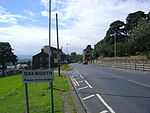Brontë Parsonage Museum
1779 establishments in EnglandBiographical museums in West YorkshireBrontë familyClergy houses in EnglandGrade I listed buildings in West Yorkshire ... and 9 more
Grade I listed housesHaworthHistoric house museums in West YorkshireHouses completed in 1779Houses in West YorkshireLiterary museums in EnglandMuseums in the City of BradfordUse British English from November 2017Women's museums in the United Kingdom

The Brontë Parsonage Museum is a writer's house museum maintained by the Brontë Society in honour of the Brontë sisters – Charlotte, Emily and Anne. The museum is in the former Brontë family home, the parsonage in Haworth, West Yorkshire, England, where the sisters spent most of their lives and wrote their famous novels. The Brontë Society, one of the oldest literary societies in the English speaking world, is a registered charity. Its members support the preservation of the museum and library collections. The parsonage is listed Grade I on the National Heritage List for England.
Excerpt from the Wikipedia article Brontë Parsonage Museum (License: CC BY-SA 3.0, Authors, Images).Brontë Parsonage Museum
Church Street, Bradford Haworth and Stanbury
Geographical coordinates (GPS) Address Phone number Website External links Nearby Places Show on map
Geographical coordinates (GPS)
| Latitude | Longitude |
|---|---|
| N 53.831277777778 ° | E -1.9574444444444 ° |
Address
Bronte Parsonage Museum
Church Street
BD22 8DR Bradford, Haworth and Stanbury
England, United Kingdom
Open on Google Maps











